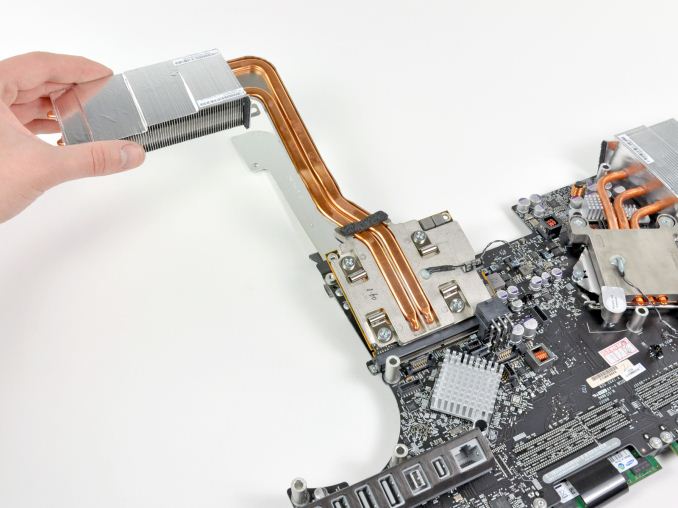Apple Initiates Video Card Replacement Program for Radeon HD 6970M Equipped Mid-2011 27” iMacs
by Ryan Smith on August 17, 2013 6:30 PM EST
In a somewhat baffling piece of news this weekend, word comes that Apple has initiated an internal replacement program for the video cards on some of their mid-2011 27” iMacs. Specifically, Apple is running into issues with the AMD’s Radeon HD 6970M that’s used on the upgraded Mid-2011 27” iMac. In a notice being circulated to Apple support staff, Apple provides a brief description of the issue:
Apple has determined that some AMD Radeon HD 6970M video cards used in 27-inch iMac computers with 3.1GHz quad-core Intel Core i5 or 3.4GHz quad-core Intel Core i7 processors may fail, causing the computer’s display to appear distorted, white or blue with vertical lines, or to turn black. iMac computers with affected video cards were sold between May 2011 and October 2012.
Jumping right into the heart of the matter, what makes this issue so stupefying from a GPU review’s perspective is that this is the first indication we’ve seen of there being an issue with this AMD GPU. The Radeon HD 6970M is of course one of the mobile variants of the Barts GPU, otherwise known in AMD’s mobile lineup as Blackcomb. Barts in turn is part of AMD’s second generation 40nm silicon, released in late 2010 well after TSMC got the kinks out of their 40nm process. As a mature product released on a mature node, at first glance there doesn’t seem to be any reason for the Barts GPU to be having longevity issues.
Meanwhile as far as implementations go, the 2011 iMacs use MXM cards, which means unlike some other Apple products the video card isn’t being soldered on directly or otherwise being assembled by Apple, greatly limiting Apple’s role in the implementation of the product. MXM allows Apple to simply order and install finished video cards from suppliers, and is also why they are able to fix the affected machines so easily, since the video card is directly replaceable. At the same time however Apple is far from the only OEM using 6970M MXM cards, which means that if the root cause of the issue is a bad video card – no matter the specific component – then any other 6970Ms may also be affected.

2011 iMac With MXM Video Card. Image Courtesy iFixit
Anyhow, we’ll avoid speculating too much here since there’s not nearly enough information available to properly identify the cause of the issue. But given just how rarely we see large scale video card longevity issues, this is somewhat worrying; solid state parts simply don’t fail that often. After all, it took a fairly serious GPU underfill issue to cause NVIDIA’s 65nm GPU failures (Bumpgate). We don’t expect the root cause of this failure to be nearly as drastic given the already-mature status of AMD’s 40nm production process, but it will still be interesting to see what that cause is, assuming we ever find out.
In any case, for affected iMac owners 9to5Mac has the full details of the replacement program, including the models and serial numbers covered. Apple will be covering the cost of the replacement for 3 years, regardless of warranty, though as is the case with most programs of this nature they are only replacing failed video cards.
Source: 9to5Mac










46 Comments
View All Comments
solipsism - Sunday, August 18, 2013 - link
The iMac has used mobile-class processors for much of its existence. The most recent usage with the desktop class processors appears to have arrived at the same time as the unibody aluminium enclosure.• http://en.wikipedia.org/wiki/IMac_(Intel-based)#Al... (pre-unibody)
• http://en.wikipedia.org/wiki/IMac_(Intel-based)#Un... (post-unibody)
name99 - Sunday, August 18, 2013 - link
I've no idea how you define a "mobile class processor" but my 2012 iMac has an quad-core i7-3770 at 3.4GHz turboi'ing up to 3.9GHz.Intel classifies this as a Desktop CPU, and the only way you're going to get anything faster is by going to a Xeon (or one of those crazy "enthusiast" CPUs).
As far as I can tell, Apple does exactly what you'd expect them to do. They design the system to support a what is generally the highest powered (non-Xeon) Intel CPU available at the time, and users who want that can pay for it. But by default they ship the system with a lower performance/lower power CPU which is both cheaper and probably a better match for most people (who will appreciate a cooler running system, and will never use require the maximum performance of the more expensive chip). Whether that default chip is classified by Intel as Desktop or Mobile is probably irrelevant to Apple's calculations, what is relevant is the cost/performance/power tradeoff, with different decisions being made for different models.
solipsism - Sunday, August 18, 2013 - link
You either didn't properly read what I wrote or you meant to reply to someone else.Kevin G - Sunday, August 18, 2013 - link
My implication is that the extra room would be used for larger heat sinks, taller fans and generally more room to move air around.name99 - Sunday, August 18, 2013 - link
(a) The iMacs in question are 2011 models. They are NOT the current thin models. They are a lot fatter than a laptop, and the GPU has a hulking great heat sink on top --- you can find tear-down pics at iFixit.(b) A persistent problem with ATI GPUs which I've noticed over the last five years or so is that ATI seems to constantly bin these things too aggressively so that a non-negligible fraction of them run very hot and eventually degenerate to displaying garbage. It's common enough that there's even a cottage industry on the internet telling you how to detach an ATI card or daughterboard and bake it in your oven for a few minutes in the hope that you'll repair minute solder breaks (which are one of the failure modes but not the only one, resulting from these constantly running so hot).
I've not noticed the same pattern in nV cards, but I've never looked at this scientifically, this is just seeing the pattern of complaints in forums over the years.
The very newest iMacs (the ones that ARE thinner) have (nV) GPUs soldered on board, not daughter cards, with no huge heat sinks, and the GPUs seem to run a lot cooler. Certainly nV seems to have taken seriously the realization that the previous model of continually cranking the things hotter and hotter was unsustainable. I've no idea whether ATI has seen the light on this point with there very latest GPUs.
Kevin G - Monday, August 19, 2013 - link
One of the changes since 2011 has been the move to 28 nm GPU's. There is a bit of power saving there. The other change with GPU's, in particular nVidia's more recent Kepler parts is that they are throttling based upon temperature which in the case of the iMac, prevent failure in most cases.As for AMD, the Radeon HD 7000 series was binned a bit lower than what they could get out of the designs (ie Radeon 7970 -> 7970 Ghz edition). I would expected better thermal controls with the next batch of GPU's due later this year since they'll be produced on the same 28 nm as the Radeon HD 7000 series.
ShaftedByHaswellAnand - Sunday, August 18, 2013 - link
I really regret buying such integrated iMac....phenomenon has not occurred yet....not sure if that is good news or bad news.....Is the 3 year limit geographically inspired (applicable law)?HisDivineOrder - Sunday, August 18, 2013 - link
Tsk, tsk. AMD, for shame. I pretty much expected it from Apple, though.Rob Sims - Monday, August 19, 2013 - link
I know, terrible customer service from Apple, giving their 'out of warranty' customers the option to have a free video card replacement, and offer refunds to those who already had to pay for it. I expect nothing less from such a ruthless company.It reminds me of when they made me replace my defunct 5 year old 1st gen iPod nano (1gb) (free of postage) with a brand new 6th gen (4gb) version due to a battery issue they discovered.
It's a good thing other computer manufacturers (Dell, HP, Clevo...etc) using the same broken AMD chipset don't offer such an appalling free repair policy¡
(I just learnt that ¡ thing from an earlier thread!)
Spunjji - Monday, August 19, 2013 - link
We don't know that the chipset itself is actually broken.